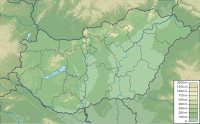 | ||
| Csopak | ||
| County | Veszprém | |
|---|---|---|
| Residents | 1.759 (2015) | |
| no tourist info on Wikidata: | ||
| location | ||
| ||
Csopak is a city in Hungary.
background
The existence of residents around today's city of Csopak goes back to primeval times. Today's excavation finds clearly show human traces from the Bronze Age, around 3000 BC. Chr.
The remains of villas and cellars were discovered from the later Roman period. Later, during the Magyar conquest around 895 AD, three villages emerged in the area. In the present place it stood Csopak, further north Nosztre and on today's railway line was Kövesd which functioned as an independent municipality under the name Balatonkövesd until 1940.
The name Csopak is used in 1277 as Chopok in a certificate of Cathedral chapter mentioned in the settlement. There are various theories about where the name Csopak comes from, it is believed that the namesake may be a brave soldier of the Grand Duke Árpád Called Sopok who was given the area because of his merits. Other opinions say the name is of Bulgarian-Turkish origin, it could have meant a species of fish. Also the theory that it has Slavic origin is meant, as early as 1121 deeds of donation were issued for adjacent vineyards, in it Kövesd is called Cuesth called.
The local area has two badly dilapidated buildings from the Árpáden period. The King's Church Stephan I. was renovated several times over the years, but in 1830 the sacred building fell victim to a lightning strike and burned down completely: the Csonkatorony These remains can be seen in the city center today. The other sacred building dates from around 1360; the ruins can be seen in the Kövesder district of Csopak in Kossuth Lajos Straße.
The main activities of the three villages used to be viticulture and milling work - mills were built on the Nosztori brook - which were used to process the grain. Grain from Somogy County was processed here in the 18th century. In the still functional water mill, built around 1910, you can see an exhibition on the history of mill work in the past.
During the rule of the Ottomans from the 16th century onwards, the three communities were depopulated. The population did not settle again until the 18th century. Beaches were the earliest to emerge along the northern shores of Lake Balaton, which belonged to around 1700 Csopak Next Balatonfüred to the first seaside resorts on Balaton. In the 20th century is Csopak a popular place for recreation, especially among the middle class population.
location
Located around 120 m above sea level, it belongs today Csopak in the small area with 20 other places too Balatonfüred.
The tourism industry and the wine-growing industry play a key role today. The wine-growing area Balatonfüred-Csopak is also known internationally for its wines. "Last but not least" disposes Csopak also over medicinal water, the "Szent József mineral spring", the spring was expanded in 1934.
getting there
By plane
By train
In the street
By boat
mobility
Tourist Attractions

- Remains of the church "Csonkatorony". From the Árpáden period of the Hungarian King Stephen I.
- Ruins of the Szent Miklós Church. 14th Century.
- Roman Catholic Church. Built in 1985.
- reformed Church
- Ranolder Castle
- "Endrődy Sándor" lookout tower. Built in 1973, located on the 317 m high mountain "Csákányhegyi-völgy".
- Watermill. Exhibition about previous mill work.
- Szent József mineral spring
- Tourist trails in the Nosztori Valley
activities
shop
kitchen
nightlife
accommodation
Learn
Practical advice
trips
literature
Web links
- Csopak - official (Hungarian)


